Marzipan
Marzipan is a confection consisting primarily of sugar or honey and almond meal (ground almonds), sometimes augmented with almond oil or extract.
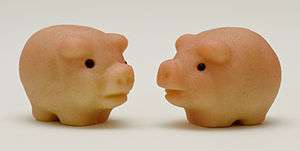 Marzipan moulded into marzipan pigs | |
| Alternative names | Marzapane, marchpane |
|---|---|
| Type | Confectionery |
| Main ingredients | Almond meal, sugar |
| Variations | Persipan, Frutta martorana |
It is often made into sweets; common uses are chocolate-covered marzipan and small marzipan imitations of fruits and vegetables. It can also be used in biscuits or rolled into thin sheets and glazed for icing cakes, primarily birthday cakes, wedding cakes and Christmas cakes. This use is particularly common in the UK, on large fruitcakes. Marzipan paste may also be used as a baking ingredient, as in stollen or banket. In some countries, it is shaped into small figures of animals as a traditional treat for New Year's Day or Christmas. Marzipan is also used in Tortell, and in some versions of king cake eaten during the Carnival season. Traditional Swedish princess cake is typically covered with a layer of marzipan that has been tinted pale green or pink.[1]
Around the world
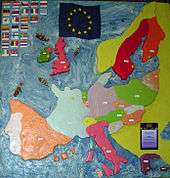
Southern Europe
In Spain it is a traditional Christmas dessert (mazapán), although in Toledo, where the first written reference of this product dates back to 1512, it is eaten all year round. In Italy, particularly in Palermo, marzipan (marzapane) is often shaped and painted with food colourings to resemble fruit—Frutta martorana—especially during the Christmas season and on Il Giorno dei Morti (All Souls' Day) on November 2. May 9 and 10 are also special days for eating marzipan in Sicily.[2] In Portugal, where the confection has been traditionally made by nuns,[3] marzipan (maçapão) is used to make fruit-shaped sweets; in the Algarve region in particular it is a very common sweet. There are other regions, as Toledo in Spain in which marzipan (mazapán) is shaped into simple animal shapes, and sometimes filled in with egg yolk (yema) and sugar. In Greece and Cyprus, marzipan is made in a variety of shapes and sizes and is almost always left white. In the islands of the Aegean in particular, white marzipan is considered a wedding treat and is served to guests at wedding feasts. In Malta marzipan is used as a filling in the traditional Maltese Easter treats called Figolla.
Western and Central Europe
In the Netherlands and Belgium, marzipan figures are given as Saint Nicholas's presents. In Germany, it is common to give marzipan in the shape of a loaf of bread, which is called "Marzipanbrot", during Christmas time or shaped as small potatoes (Marzipankartoffeln). Besides Stollen, marzipan is often featured as an ingredient in seasonal baked goods, such as Bethmännchen and other Christmas cookies. One traditional new year present is known as a Glücksschwein ("lucky pig"). Mozartkugel from Austria are a famed export made of marzipan balls dipped in dark chocolate.
In the United Kingdom, celebratory fruitcakes are decorated with a layer of marzipan- particularly Christmas cake which is covered with white sugar icing, and at Easter the Simnel cake contains a layer of marzipan , a further layer decorates the top and 12 spheres symbolise the apostles of Christ- the marzipan is lightly grilled or toasted to colour it. In Geneva, a traditional part of the celebration of L'Escalade is the ritual smashing of a chocolate cauldron filled with marzipan vegetables, a reference to a Savoyard siege of the city which was supposedly foiled by a housewife with a cauldron of boiling soup.
Northern Europe
In Denmark, Sweden and Norway, it is common to eat marzipan pigs for Christmas and marzipan shaped as eggs for Easter, and Kransekage for New Year's Eve.
In Tallinn, in Maiasmokk café, there is a small museum dedicated to the history and manufacture of marzipan.[4]
Middle East
In the Middle East, marzipan (known as لوزینه lozina, lowzineh, a Persian word derived from lawz, "almond") is flavoured with orange-flower water and shaped into roses and other delicate flowers before they are baked. Marzipan can also be made from oatmeal, farina, or semolina.[5] For Jews in Iran, marzipan fruit is a traditional Passover treat, replacing biscuits and cakes.
The Americas
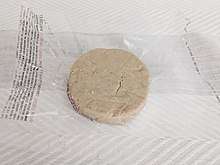
In Latin American cuisine, marzipan is known by the Spanish word mazapán and is also traditionally eaten at Christmas, although Latin American mazapán is generally made with peanuts instead of almonds as the Spanish mazapán.[6]
Asia
In the Indian state of Goa, marzipan (maçapão) was introduced from Portugal. However, the Goan version uses cashew nuts instead of almonds. Goan marzipan is used to make Easter eggs. It is also used to make Christmas sweets in various shapes like fruits, flowers, stars, etc. Similarly, in the city of Bombay(Mumbai), the East Indians mould their cashewnut-based or almond-based marzipan into different shapes for Christmas and into marzipan eggs, chickens and bonnets for Easter.
In the Philippines marzipan was brought from Spain, mazapán de pili (Spanish for "pili marzipan") is made from pili nuts.
History
There are two proposed lines of origin for marzipan; they are not necessarily contradictory and may be complementary, as there have always been Mediterranean trade and cooking influences.[7] Other sources establish the origin of marzipan in China, from where the recipe moved on to the Middle East and then to Europe through Al-Andalus.[8]
Northeast Mediterranean line
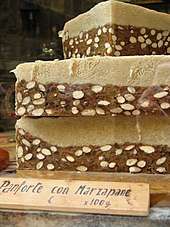
Although it is believed to have been introduced to Eastern Europe through the Turks (badem ezmesi in Turkish, and most notably produced in Edirne), there is some dispute between Hungary and Italy over its origin.[9] Marzipan became a specialty of the Hanseatic League port towns. In particular, the cities of Lübeck and Tallinn have a proud tradition of marzipan manufacture. Examples include Lübecker Marzipan (PGI[10]). The city's manufacturers like Niederegger still guarantee their marzipan to contain two-thirds almonds by weight, which results in a product of highest quality. Historically, the city of Königsberg in East Prussia was also renowned for its distinctive marzipan production. Königsberg marzipan remains a special type of marzipan in Germany that is golden brown on its surface and sometimes embedded with marmalade at its centre.[11]
Iberian Peninsula line
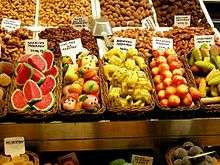
Another possible geographic origin are the parts of Spain that were known as Al-Andalus. In Toledo (850-900, though more probably 1150 during the reign of Alfonso VII) this specialty was known as Postre Regio (instead of Mazapán). There are also mentions in The Book of One Thousand and One Nights of an almond paste eaten during Ramadan and as an aphrodisiac.[12] Mazapán is Toledo's most famous dessert, often created for Christmas, and has PGI status.[13] For this, almonds have to be at least 50% of the total weight, following the directives of Mazapán de Toledo regulator counseil.[14] Another idea to support this line is the important tradition of another Spanish almond-based Christmas confectionery, the turrón.
In the U.S., marzipan is not officially defined, but it is generally made with a higher ratio of sugar to almonds than almond paste.[15] One brand, for instance, has 28% almonds in its marzipan, and 45% almonds in its almond paste. However, in Sweden and Finland almond paste refers to a marzipan that contains 50% ground almonds, a much higher quality than regular marzipan. In Germany, Lübecker Marzipan is known for its quality. It contains 66% almonds.[16] The original manually produced Mozartkugeln are made from green pistachio marzipan.
Variations
Persipan is a similar, yet less expensive product, in which the almonds are replaced by apricot or peach kernels. Many confectionery products sold as marzipan are made from less expensive materials, such as soy paste and almond essence.[17] To control and detect the authenticity of marzipan, polymerase chain reaction methods can differentiate almonds from substitutes and adulterants at concentrations less than 1%.[18] German marzipan is made by grinding whole almonds with sugar and partially drying the paste, and French marzipan (called 'massepain') is made by combining ground almonds with sugar syrup.[19] Some marzipan is flavoured with rosewater. Spanish marzipan is made without bitter almonds. In the U.S, bitter almonds are not used in marzipan because the importation of bitter almonds into the U.S. is prohibited by U.S. law, owing to them containing a substance related to cyanide.[20] Sugar free marzipan can be made by replacing sugar with polyols such as maltitol.[21]
Etymology
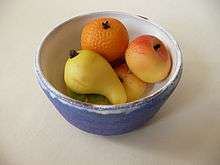
The German name has largely ousted the original English name marchpane with the same apparent derivation: "March bread". (The word marchpane occurs in Shakespeare's Romeo and Juliet, Act 1, Scene 5, Line 9.) Marzapane is documented earlier in Italian than in any other language, and the sense "bread" for pan is Romance. The origin could be from the Latin term "martius panis", which means bread of March. However, the ultimate etymology is unclear; for example, the Italian word derives from the Latin words "Massa" (itself from Greek Μάζα "Maza") meaning pastry and "Pan" meaning bread, this can be particularly seen in the Provençal massapan, the Portuguese maçapão (where 'ç' is an alternative form for the phoneme 'ss') and old Spanish mazapán – the change from 'ss' to 'z' in Latin words was common in old Spanish and the 'r' appeared later. It could also be derived from martis pan, bread of March. Among the other possible etymologies set forth in the Oxford English Dictionary, one theory proposes that the word "marzipan" may be a corruption of Martaban, a Burmese city famous for its jars.
The Real Academia Española[22] suggests the idea of the Spanish word mazapán to be derived from the Hispanic Arabic بسمة pičmáṭ, which is derived from the Greek παξαμάδιον.
Another source could be from Arabic موثابان mawthābān "king who sits still".[23] The Arabic, Latinised as matapanus, was used to describe a Venetian coin depicting an enthroned Christ the King.[24] These coins were stored in ornate boxes. From about the fifteenth century, when the coins were no longer in circulation, the boxes became decorative containers for storing and serving luxury sweetmeats. One such luxury that crept into the box in the sixteenth century is the now-famous almond-flavoured marzipan, named (at least proximately) after the box in which it was stored.
However, if marzipan has its origin in Persia, it is not unlikely that the name may come from Marzban (in Persian: مرزبان, derived from the words Marz مرز meaning "border" or "boundary" and the suffix -bān بان meaning guardian), a class of margraves or military commanders in charge of border provinces of the Sassanid Empire of Persia (Iran) between the 3rd and 7th centuries.
Production
To produce marzipan, raw almonds are cleaned "by sieving, air elutriation, and other electronic or mechanical devices",[25] then immersed in water with a temperature just below the boiling point for about five minutes, in a process known as blanching. This loosens the almonds' skin, which is removed by passing the almonds through rubber-covered rotating cylinders. This process reduces hydrogen cyanide (HCN) concentration and increases water content.[26] They are then cooled, after which they are coarsely chopped and ground, with up to 35% sugar, into almond flour.[27]
The almond flour mixture is roasted and cooled, after which sucrose (table sugar) and possibly a binding agent such as starch syrup or sorbitol are added.[27] It may then be moulded into any shape. Marzipan must be covered in an airtight container to prevent it from hardening and dehydrating. It should be protected from direct light to prevent rancidity of almond oil, a result of lipid oxidation.
Science
Molecular composition

The aroma and flavor of marzipan can be attributed to benzaldehyde and hydrogen cyanide, which both derive from amygdalin, a compound naturally present in almonds.
Physical structure
Marzipan is a food emulsion that contains 4 phases: a solid phase of suspended particles including almonds and sugars, a suspended air pocket phase formed from incorporated air during mixing, a water phase, and a lipid phase from almond oil.[28] The phases can separate when left alone for long periods of time. It is stabilized by the phospholipids and triglycerides found in the almond cells. The fatty acids found in almonds include saturated fats such as stearic acid and unsaturated fats such as linoleic acid.[29] Emulsifiers can be added during production to increase shelf life.
Marzipan's softness is a balance between the solid and liquid components. It should have a moisture content of less than 10%.[30]
See also
- Aboukir almonds – marzipan-covered almonds originating in Abu Qir
- Battenberg cake – a light sponge cake covered in marzipan
- Bethmännchen – a traditional German pastry which contains marzipan
- Cassata – a multi-layered Sicilian sponge cake covered in marzipan
- Frangipane – an almond-flavored pastry cream
- Halva – Some types are made from sesame paste or sunflower seed butter and sugar
- List of almond dishes
- Frutta martorana - marzipan confectionary shaped and colored to resemble fruit
- Simnel cake – a light fruit cake covered in marzipan
References
- Sinclair, Pat (2011). Scandinavian Classic Baking. Gretna, Louisiana: Pelican Publishing. p. 45. ISBN 978-1-58980-897-3.
- Barer-Stein: 1999. Page 268
- Barer-Stein: 1999. Page 356
- "Kalev Marzipan Museum Room". Kalev. Archived from the original on 8 December 2015. Retrieved 8 September 2015.
- Barer-Stein: 1999. Page 245
- Zalben, Lee (December 22, 2010). "What's the Deal with Marzipan?". Serious Eats.
- "Aramco World – Arabs, Almonds, Sugar and Toledo". Archived from the original on 2013-12-25. Retrieved 2017-09-27.
- "Mazapan artesano de Toledo. Gastronomía en Castilla-La Mancha". Archived from the original on 2007-09-01.
- Mazapan.es.
- EU profile – Lübecker Marzipan (accessed 07/06/2009).
- The main difference from the Luebeck style is that Königsberger Marzipan is browned on the surface and often has marmalade embedded in the centre. See German wikipedia entry here for more information. In Germany, the siblings of refugees from Königsberg still produce marzipan following traditional recipes, e.g. Gehlhaar confectioners in Wiesbaden (1912/45, seat Königsberg).
- Islamyal.andalus.org Archived 2007-09-27 at the Wayback Machine.
- EU Profile — Marzipan Toledo (accessed 07/06/2009).
- "Mazapan". Archived from the original on 2003-07-27.
- Welcome Love n Bake
- "Lubeca Lübecker Marzipan-Fabrik – Lübecker Marzipan".
- Minifie:1989. Page 594
- Brüning, Philipp; Haase, Ilka; Matissek, Reinhard; Fischer, Markus (2011-11-23). "Marzipan: polymerase chain reaction-driven methods for authenticity control". Journal of Agricultural and Food Chemistry. 59 (22): 11910–11917. doi:10.1021/jf202484a. ISSN 1520-5118. PMID 21999195.
- Davidson et al: 2006. Page 484
- Mendel: 2008. Page 288
- Grenby, Trevor (1996). Advances in Sweeteners. Springer. p. 103. ISBN 978-0-7514-0331-2.
- rae.es.
- Etymonline.com.
- Patridge: 1958.
- Minifie: 1989, page 594.
- Belitz et al: 2009, page 881. In the traditional production of marzipan raw filler, sweet almonds are scalded, peeled on rubber-covered rolls, coarsely chopped, and then ground with the addition of not more than 35% of sucrose.
- Belitz et al: 2009, page 881.
- Christensen, Jakob; Nørgaard, Lars; Heimdal, Hanne; Pedersen, Joan; Engelsen, Søren (2004-05-07). "Rapid spectroscopic analysis of marzipancomparative instrumentation". Journal of Near Infrared Spectroscopy. 12 (1): 63. Bibcode:2004JNIS...12...63C. doi:10.1255/jnirs.408. ISSN 0967-0335.
- "Almond Board of California – Almond Composition" (PDF).
- Booth, R. Gordon (2012-12-06). Snack Food. Springer Science & Business Media. ISBN 978-1-4613-1477-6.
Bibliography
- Barer-Stein, Thelma (1999). You Eat What You Are: People, Culture and Food Traditions. Firefly Books. ISBN 1-55209-365-4.
- Belitz, Hans-Dieter; Grosch, Werner; Schieberle, Peter (2009). Food Chemistry. Springer. ISBN 978-3-540-69933-0.
- Davidson, Jane L.; Davidson, Alan; Saberi, Helen; Jaine, Tom (2006). The Oxford companion to food. Oxford: Oxford University Press. ISBN 0-19-280681-5.
- Mendel, Janet (2008). Cooking from the Heart of Spain. Frances Lincoln Publishers. ISBN 978-0-7112-2873-3.
- Minifie, Bernard W. (1989). Chocolate, Cocoa, and Confectionery: Science and Technology. Berlin: Springer. ISBN 0-8342-1301-X.
- Patridge, E. (1958). "marchpane". Origins: a short etymological dictionary of the modern English. London: Routledge. p. 380.
External links
| Wikisource has the text of the 1911 Encyclopædia Britannica article Marchpane. |
